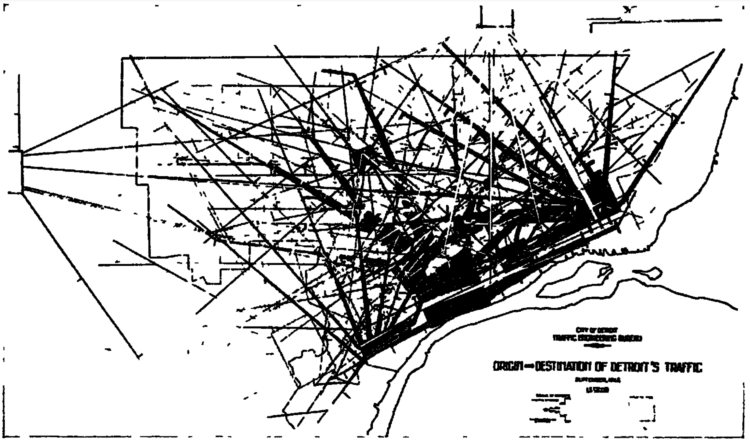Subscribe to blog updates via email »
Desire Paths – Love Your Work, Episode 297
 Desire paths are trails left on the ground, by anything that frequently travels along a route. There are subcultures fascinated by desire paths as symbols of collective wisdom, disregard for authority, or mere evidence of existence. Desire paths are also celebrated as a design technique. Desire paths in their pure form are about what you can see, but the characteristics of desire paths – which you can’t always see – can help you optimize your life and gain clarity in your creative projects.
Desire paths are trails left on the ground, by anything that frequently travels along a route. There are subcultures fascinated by desire paths as symbols of collective wisdom, disregard for authority, or mere evidence of existence. Desire paths are also celebrated as a design technique. Desire paths in their pure form are about what you can see, but the characteristics of desire paths – which you can’t always see – can help you optimize your life and gain clarity in your creative projects.
Listen to the Podcast

WANT TO WRITE A BOOK?
Download your FREE copy of How to Write a Book »
(for a limited time)
- Listen in iTunes >>
- Download as an MP3 by right-clicking here and choosing “save as.”
- RSS feed for Love Your Work
Desire path examples
Desire paths are also known by a number of other names: cattle trails, cow paths, elephant paths, just to name a few. In forests or grassy meadows, it seems pretentious to call them desire paths – they’re just paths.
Desire paths that question authority
Desire paths are most interesting when they show up in places where a man-made path has already been put in place. A sidewalk turns a corner at a ninety-degree angle, but as people cut the corner, a desire path develops at forty-five degrees.
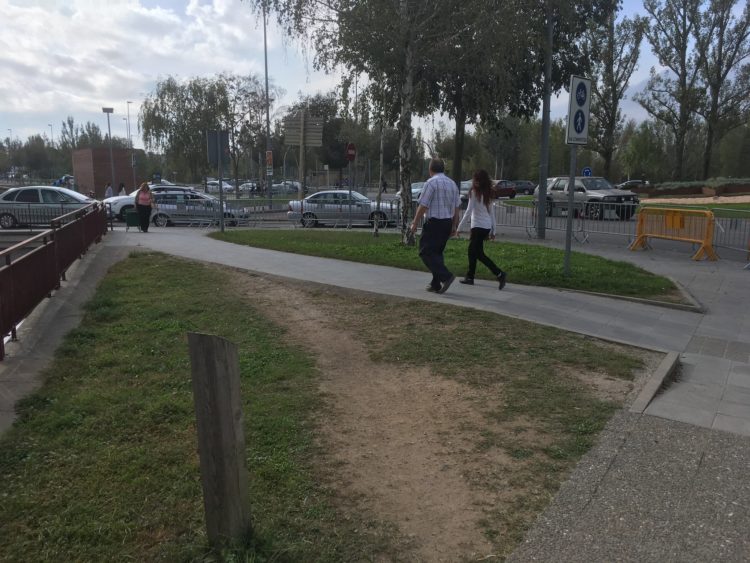
Flickr: felixphs
An overgrown hedge encroaches on a sidewalk. To avoid squeezing between the hedge and a tree, people walk off the sidewalk and around the tree, and a desire path develops.
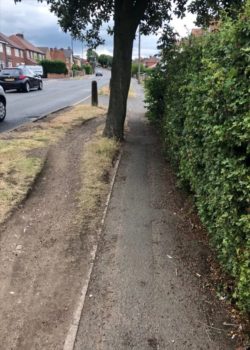
Reddit: poshbo
A landscape architect tries to get fancy by building a curved path, but people instead take a straight path, and a desire path cuts through the grass.
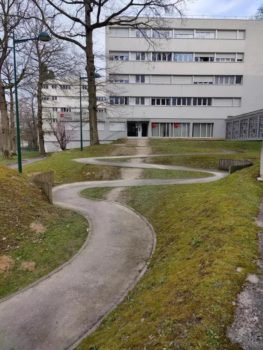
Reddit: BritishFoSho
These desire paths that eschew the suggestions of man-made paths are like visual jokes that show a disregard for authority.
Desire paths that acknowledge existence
But some desire paths acknowledge the existence of a single being. A dog leaves a desire path where he’s cut across the yard a thousand times.
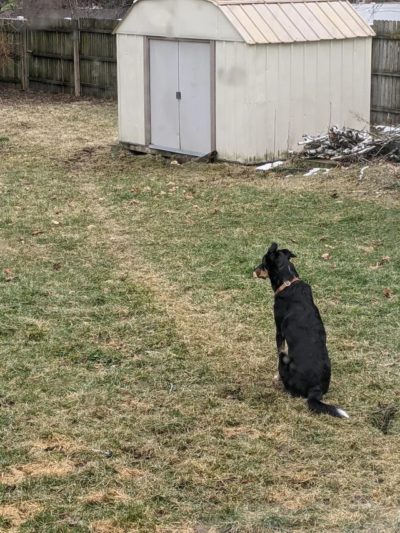
Reddit: aspara_gus
A woman leaves a desire path where all summer she’s walked off the end of a dock, into the shallow water, to the shore of a lake.
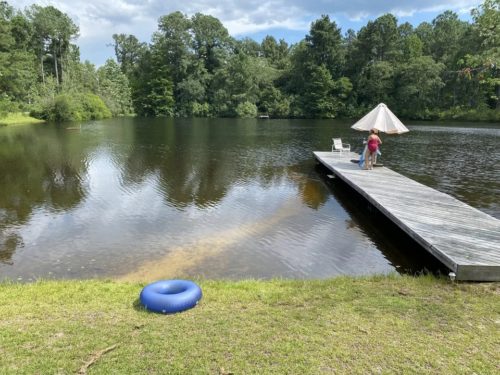
Reddit: patprika
When a single being who has left a desire path passes away, the desire path remains as a reminder of their existence. The thought of nature reclaiming the desire path – for example, the grass growing back – is a sad reminder of how long they’ve been gone, and a reminder one day we’ll be gone, too.
But the being doesn’t even have to be a living one. Delivery robots have left desire paths, their tire tracks marking the sidewalk with GPS precision.
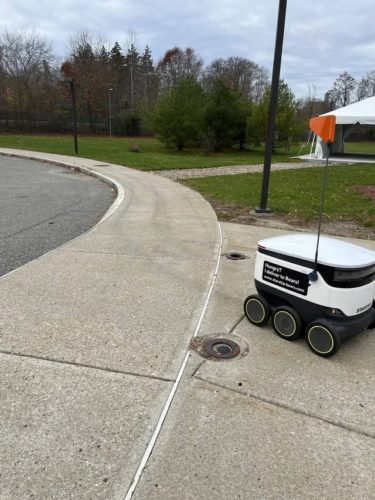
Reddit: EightBItDerp
Desire paths as a design technique
The most striking thing about desire paths is they can be used as a design technique. As I said, desire paths are like visual jokes that show a disregard for authority. They poke fun at civilization’s feeble attempts to plan, make decisions for others, or control people.
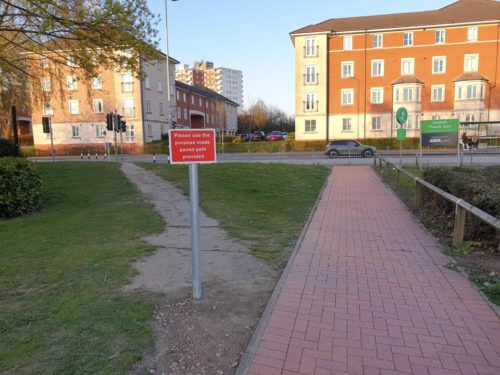
Reddit: Dragonblaze123
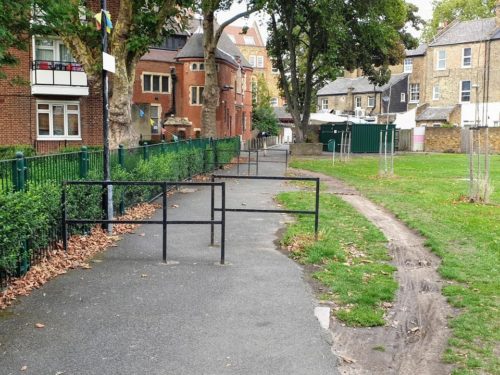
Reddit: jacksterooney
Sometimes “authority” surrenders to the crowd and lets desire paths do the decision-making for them.
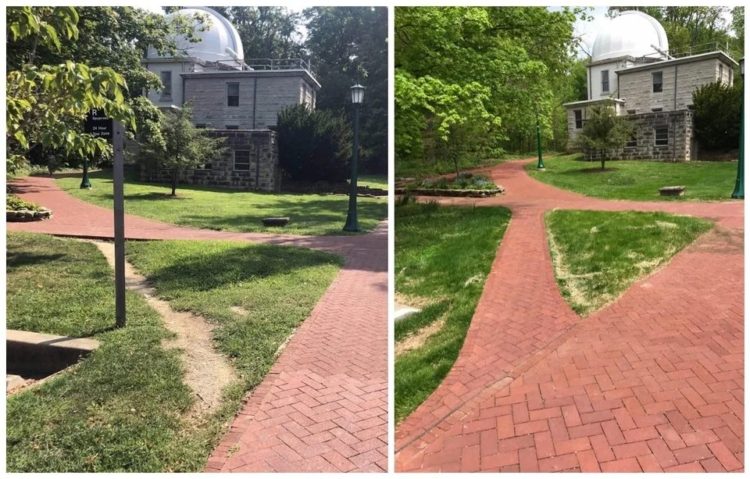
Reddit: CollectiveAnimal
University campuses are often full of desire paths. With so many students migrating from one of many buildings to one of many other buildings, there’s no way to predict what routes exactly will be the most efficient.
So some schools, such as Ohio State University, held off on creating paved paths. Once the desire paths showed up, they then paved on top of them. The result is a latticework of criss-crossing paths, of varying widths, that no single human would have designed.
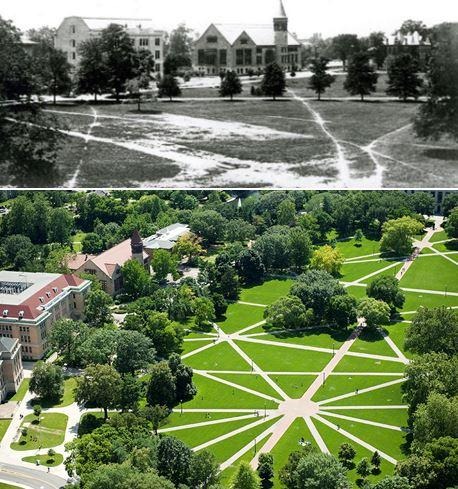
Reddit: PrinceAlyBaba
Desire paths aren’t always good
But sometimes “authority” has a good reason for building a path that seems inefficient. On the leading subculture of desire-path enthusiasts – Reddit’s desire paths community – parks planners have explained that nature trails often have switchbacks going back and forth across steep inclines, because such a design prevents soil erosion. When people cut across these switchbacks, hiking directly up the hill, they hasten erosion.

Reddit: Skin_Kazoo
Additionally, desire paths express the desires of the majority. Sometimes the path expressed by desire paths don’t work for people in the minority. That curved path that looks like the result of a landscape architect gone wild might soften the incline for people in wheelchairs – and how does that work out when path installation is delayed until desire paths form?
Ultimately, people are going to tend toward their desires to get to their destinations quickly. Whatever practical reasons “authority” has for designing a path, the wisdom carried by desire paths can’t be ignored.
The power of invisible desire paths
Desire paths, in their pure form, are about what you can see. It seems the use of desire paths in design projects originated with analyzing data you can’t see. A 1942 transit study in Detroit charted origins and destinations of commuter trips, to determine where best to build roads.
If you break the phenomenon of desire paths down to its essential components, you can find desire paths you can’t see, and harness their power to optimize your life and achieve clarity in creative projects.
When used as a design technique, a desire path essentially does four things:
- A good-enough solution
- Collects data
- Exposes a pattern in the data
- Which leads to an ideal solution
The unmodified ground is a good-enough solution people can use. Through the usage patterns of that good-enough solution, data builds up. Each footprint is a piece of data. The footprints don’t overlap, all in the same place. Instead, a pattern emerges, in the form of a path. That pattern is then used to determine an ideal solution. In the case of a college campus, that ideal solution is usually a paved sidewalk where the desire path once was.
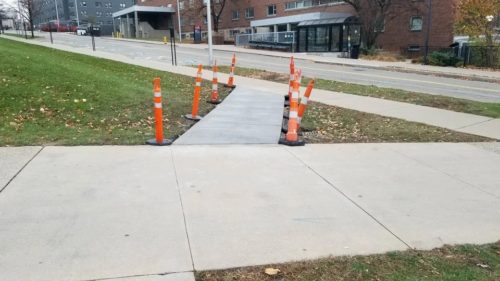
Reddit: jeenyus024
1. Start with a prototype
When a desire path forms, the untreated ground is essentially a prototype. So to create an invisible desire path, build or find a prototype. Find a low-cost, low-commitment way to give yourself a good-enough solution.
For example, if you’re looking for the perfect backpack, you could take the top-down approach that desire paths so often protest: You could plan out everything you want your backpack to hold and do, then design a custom backpack. Or, you could start with a prototype: Buy any cheap backpack at a thrift store, and try it out.
2. Collect data
Desire paths collect data based upon use of a prototype. Once you have a good-enough solution, you’re collecting data as you use it.
With your cheap backpack, maybe you notice the straps gets loose, or dig into your shoulder. Maybe a pen falls out of it, or you find yourself rummaging through a big compartment full of small items.
3. Look for patterns
Desire paths collect data, but that data is only useful once a pattern emerges. When a desire path forms, you can see it, but when an invisible desire path forms, you can’t.
After enough time using your prototype, individual bits of data turn into patterns. Maybe a pen fell out of your cheap backpack only once and you fixed the straps so they didn’t loosen anymore, but the strap kept digging into your shoulder and you got sick of rummaging through a compartment full of small items.
You’ve found your invisible desire path: You want a backpack with comfortable straps, and lots of small compartments for small items.
4. Find a solution
When desire paths are used as a design feature, the visible path becomes the backbone of the solution. The designers simply pave a path over the desire path.
Once you’ve found an invisible desire path, that becomes the backbone of your solution. Now that you’ve used a prototype enough times for patterns to emerge, you can find a solution that fits those patterns.
Desire paths in creative projects
Now how can invisible desire paths help you gain clarity on creative projects? Creative projects are a lot like choosing a backpack: You have a variety of requirements and preferences, not all of them are clear, and many contradict one another. There’s no one perfect solution, but there’s some ideal solution that balances everything.
Too often, we approach creative projects thinking top-down: We don’t want to act until we have the perfect plan. But the perfect plan doesn’t exist.
The best way to find an ideal plan is create an invisible desire path: Find a good-enough solution, collect data, and see what patterns emerge. Only then can you quickly and efficiently get where you’re going.
Thank you for having me on your show!
Thank you for having me on your show. Thank you to Ajay Mathur at the Be Yourself show.
As always, you can find interviews of me on my interviews page.
Join the Patreon for (new) bonus content!
I've been adding lots of new content to Patreon. Join the Patreon »
Subscribe to Love Your Work
Listen to the Podcast
- Listen in iTunes >>
- Download as an MP3 by right-clicking here and choosing “save as.”
- RSS feed for Love Your Work
Theme music: Dorena “At Sea”, from the album About Everything And More. By Arrangement with Deep Elm Records. Listen on Spotify »

